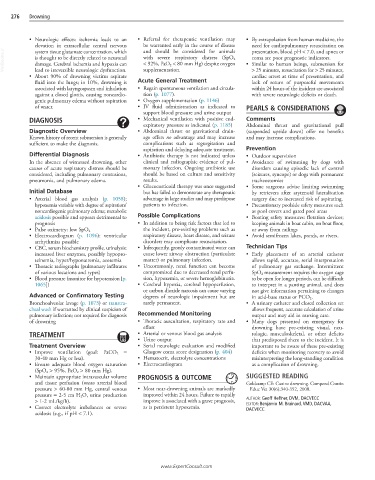Page 609 - Cote clinical veterinary advisor dogs and cats 4th
P. 609
276 Drowning
• Neurologic effects: ischemia leads to an • Referral for therapeutic ventilation may • By extrapolation from human medicine, the
elevation in extracellular central nervous be warranted early in the course of disease need for cardiopulmonary resuscitation on
and should be considered for animals
VetBooks.ir is thought to be directly related to neuronal with severe respiratory distress (SpO 2 • Similar to human beings, submersion for
system tissue glutamate concentration, which
presentation, blood pH < 7.0, and apnea or
coma are poor prognostic indicators.
< 92%, PaO 2 < 80 mm Hg) despite oxygen
damage. Cerebral ischemia and hypoxia can
lead to irreversible neurologic dysfunction.
• About 90% of drowning victims aspirate supplementation. > 25 minutes, resuscitation for > 25 minutes,
cardiac arrest at time of presentation, and
fluid into the lungs; in 10%, drowning is Acute General Treatment lack of return of purposeful movements
associated with laryngospasm and inhalation • Regain spontaneous ventilation and circula- within 24 hours of the incident are associated
against a closed glottis, causing noncardio- tion (p. 1077). with severe neurologic deficits or death.
genic pulmonary edema without aspiration • Oxygen supplementation (p. 1146)
of water. • IV fluid administration as indicated to PEARLS & CONSIDERATIONS
support blood pressure and urine output
DIAGNOSIS • Mechanical ventilation with positive end- Comments
expiratory pressure as indicated (p. 1185) Abdominal thrust and gravitational pull
Diagnostic Overview • Abdominal thrust or gravitational drain- (suspended upside down) offer no benefits
Known history of recent submersion is generally age offers no advantage and may increase and may increase complications.
sufficient to make the diagnosis. complications such as regurgitation and
aspiration and delaying adequate treatment. Prevention
Differential Diagnosis • Antibiotic therapy is not indicated unless • Outdoor supervision
In the absence of witnessed drowning, other clinical and radiographic evidence of pul- • Avoidance of swimming by dogs with
causes of acute respiratory distress should be monary infection. Ongoing antibiotic use disorders causing episodic lack of control
considered, including pulmonary contusions, should be based on culture and sensitivity (seizures, syncope) or dogs with permanent
pneumonia, and pulmonary edema. results. tracheostomies
• Glucocorticoid therapy was once suggested • Some surgeons advise limiting swimming
Initial Database but has failed to demonstrate any therapeutic by retrievers after arytenoid lateralization
• Arterial blood gas analysis (p. 1058); advantage in large studies and may predispose surgery due to increased risk of aspirating.
hypoxemia variable with degree of aspiration/ patients to infection. • Precautionary poolside safety measures such
noncardiogenic pulmonary edema; metabolic as pool covers and gated pool areas
acidosis possible and appears detrimental to Possible Complications • Boating safety measures: flotation devices;
prognosis • In addition to being risk factors that led to keeping animals in boat cabin, on boat floor,
the incident, pre-existing problems such as or away from railings
• Pulse oximetry: low SpO 2
• Electrocardiogram (p. 1096): ventricular respiratory disease, heart disease, and seizure • Avoid semifrozen lakes, ponds, or rivers.
arrhythmias possible disorders may complicate resuscitation.
• CBC, serum biochemistry profile, urinalysis: • Infrequently, grossly contaminated water can Technician Tips
increased liver enzymes, possibly hypopro- cause lower airway obstruction (particulate • Early placement of an arterial catheter
teinemia, hyper/hyponatremia, azotemia matter) or pulmonary infection. allows rapid, accurate, serial interpretation
• Thoracic radiographs (pulmonary infiltrates • Uncommonly, renal function can become of pulmonary gas exchange. Intermittent
of various locations and types) compromised due to decreased renal perfu- SpO 2 measurement requires the oxygen cage
• Blood pressure (monitor for hypotension [p. sion, hypoxemia, or severe hemoglobinuria. to be open for longer periods, can be difficult
1065]) • Cerebral hypoxia, cerebral hypoperfusion, to interpret in a panting animal, and does
or carbon dioxide narcosis can cause varying not give information pertaining to changes
Advanced or Confirmatory Testing degrees of neurologic impairment but are in acid-base status or PCO 2 .
Bronchoalveolar lavage (p. 1073) or transtra- rarely permanent. • A urinary catheter and closed collection set
cheal wash if warranted by clinical suspicion of allows frequent, accurate calculation of urine
pulmonary infection; not required for diagnosis Recommended Monitoring output and may aid in nursing care.
of drowning • Thoracic auscultation, respiratory rate and • Many dogs presented on emergency for
effort drowning have pre-existing visual, neu-
TREATMENT • Arterial or venous blood gas analysis rologic, musculoskeletal, or other deficits
• Urine output that predisposed them to the incident. It is
Treatment Overview • Serial neurologic evaluation and modified important to be aware of these pre-existing
• Improve ventilation (goal: PaCO 2 = Glasgow coma score designation (p. 404) deficits when monitoring recovery to avoid
30-40 mm Hg or less). • Hematocrit, electrolyte concentrations misinterpreting the long-standing condition
• Ensure adequate blood oxygen saturation • Electrocardiogram as a complication of drowning.
(SpO 2 > 95%, PaO 2 > 80 mm Hg).
• Maintain appropriate intravascular volume PROGNOSIS & OUTCOME SUGGESTED READING
and tissue perfusion (mean arterial blood Goldcamp CE: Canine drowning. Compend Contin
pressure > 60-80 mm Hg, central venous • Most near-drowning animals are markedly Educ Vet 30(6):340-352, 2008.
pressure = 2-5 cm H 2O, urine production improved within 24 hours. Failure to rapidly
> 1-2 mL/kg/h). improve is associated with a grave prognosis, AUTHOR: Geoff Heffner, DVM, DACVECC
• Correct electrolyte imbalances or severe as is persistent hypoxemia. EDITOR: Benjamin M. Brainard, VMD, DACVAA,
DACVECC
acidosis (e.g., if pH < 7.1).
www.ExpertConsult.com

